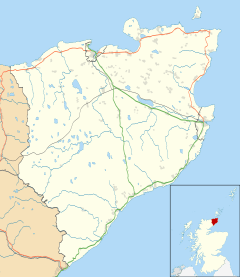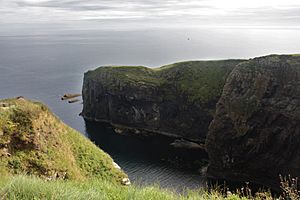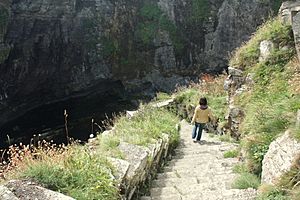Whaligoe facts for kids
Quick facts for kids Whaligoe |
|
|---|---|
| OS grid reference | ND321404 |
| Council area | |
| Lieutenancy area | |
| Country | Scotland |
| Sovereign state | United Kingdom |
| Post town | LYBSTER |
| Postcode district | KW2 |
| Dialling code | 01955 |
| Police | Northern |
| Fire | Highlands and Islands |
| Ambulance | Scottish |
| EU Parliament | Scotland |
| UK Parliament |
|
| Scottish Parliament |
|
Whaligoe is a small, historic port located in Caithness, a beautiful area in the Highland region of Scotland. It's famous for its unique steps carved into the cliffs.
Back in 1786, a famous engineer named Thomas Telford visited Whaligoe. He was looking at fishing harbours for the British Fishing Society. He thought Whaligoe was a "terrible spot" because of its challenging location.
However, a brave man named Captain David Brodie didn't give up on Whaligoe. He spent £8 to create the famous 330 steps down to the harbour. This was a lot of money back then! His effort paid off. By 1814, the small harbour was busy, supporting 14 boats that went out to catch herring.
Contents
Whaligoe Steps: A Historic Stairway
The Whaligoe Steps are a special man-made stairway. There are 365 steps that lead down to a natural harbour between two tall sea cliffs. This spot was once a busy place where fishing boats would land their catch.
Location and History of the Steps
The steps are found just south of the town of Wick in Caithness. This is on Scotland's most northeastern coast. The steps were first built in the mid-1700s. They were used by fisherwomen to carry baskets of fish up from the boats.
Life of the Fisherwomen
These strong women, some even in their seventies, would clean the fish. They handled Herring, cod, Haddock, or Ling. Then, they would carry the heavy baskets of fish up the many steps. From there, they walked about 7 to 8 miles to sell the fish in Wick.
Barrels were made at the top of the cliffs. These barrels were carried down to store salted herring. Then, the barrels were loaded onto schooner ships to be taken away.
Visiting Whaligoe Today
Today, the 'Whaligoe Steps' are a popular place for visitors. However, they can be hard to find because there are no signs on the main road. As you visit, you might see sea birds like oystercatchers and terns nesting in the cliffs. They often circle on the wind down to the water. There is also a sea cave nearby that you can explore.
Keeping the Steps Maintained
The steps have been repaired several times over the years. In the early 1800s, they were fixed. More recently, they have been repaired again. In 1975, a dedicated person named Etta Juhle cleared about 30 tons of rubble by herself after a landslide.
Since 1998, David Nicolson from Ulbster has worked continuously on the steps. He has been helped by local historian Iain Sutherland and many other volunteers. They quarry stone, carry it up or down the cliffs, and cut the grass every few weeks in summer. The 'Whaligoe Steps' have even won the Shell Best of Britain award twice!
Fishing Activity Over Time
In 1808, seven boats used Whaligoe for fishing. By 1826, this number grew to twenty-four boats. However, after that, the number of boats using the harbour quickly went down.




